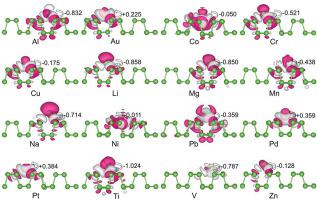Micro and Nanostructures ( IF 3.1 ) Pub Date : 2021-03-02 , DOI: 10.1016/j.spmi.2021.106852 Zhen Cui , Mingjun Wang , Nan Lyu , Shuang Zhang , Yingchun Ding , Kaifei Bai

|
The optical, magnetism and electronic characteristics of 16 types of transition metals adsorbed puckered arsenene (TM-arsenene) were investigated by the first principles calculations. The results illustrate that adsorption energy of all TM-arsenene systems is negative, indicating that all TM-arsenene systems possess good stability, whereas the most stable position of TM-arsenene systems is distinct. The observed Mg-, Ni-, Pb-, Pd-, Pt- and Zn-arsenene systems remain nonmagnetic semiconductors, while the Al-, Cu-, Li-, and Na-arsenene systems exhibit the metal behavior. Interestingly, the Co- and V-arsenene systems appear magnetic metal behavior, whereas the Au-, Cr-, Mn-, and Ti-arsenene systems emerge magnetic semiconductor. Moreover, the charge transfer occurs between the puckered arsenene and TM. The work function of the Al-, Au-, Cr-, Cu-, Li-, Mg-, Mn-, Na-, Ni-, Pb-, Ti- and V-arsenene systems is lower than that of pristine puckered arsenene. In particular, the work function of Ti-arsenene systems is as low as 3.26 eV, which is 24.2% lower than that of pristine puckered arsenene. Importantly, the absorption spectrum of puckered arsenene system has two puissant visible absorption peaks which located at 432.3 nm and 645.8 nm, and the absorption intensity in the visible light range is enhanced after the adsorption of transition metal. Therefore, these results reveal that TM-arsenene systems can be effectively used to design for field emission, spin electronics and photocatalysis nanodevices.
中文翻译:

过渡金属吸附的皱纹砷的电子,磁性和光学性质
通过第一性原理计算研究了16种过渡金属吸附的皱纹砷(TM-砷)的光学,磁性和电子特性。结果表明,所有TM-砷系统的吸附能均为负值,表明所有TM-砷系统均具有良好的稳定性,而TM-砷系统的最稳定位置则不同。观察到的Mg-,Ni-,Pb-,Pd-,Pt-和Zn-砷体系仍然是非磁性半导体,而Al-,Cu-,Li-和Na-砷体系则表现出金属行为。有趣的是,Co-和V-砷系统表现出磁性金属行为,而Au-,Cr-,Mn-和Ti-砷系统表现出磁性半导体。而且,在起皱的砷与TM之间发生电荷转移。Al,Au,Cr,Cu,Li,Mg-,Mn-,Na-,Ni-,Pb-,Ti-和V-砷体系低于原始的皱纹砷。尤其是,Ti-砷系统的功函低至3.26 eV,比原始的皱纹砷低24.2%。重要的是,皱纹砷系统的吸收光谱具有两个puissant可见光吸收峰,分别位于432.3 nm和645.8 nm,并且在吸收过渡金属后,可见光范围内的吸收强度得以提高。因此,这些结果表明,TM-砷体系可以有效地用于场发射,自旋电子学和光催化纳米器件的设计。比原始褶皱的砷低2%。重要的是,皱纹砷系统的吸收光谱具有两个puissant可见光吸收峰,分别位于432.3 nm和645.8 nm,并且在吸收过渡金属后,可见光范围内的吸收强度得以提高。因此,这些结果表明,TM-砷体系可以有效地用于场发射,自旋电子学和光催化纳米器件的设计。比原始褶皱的砷低2%。重要的是,皱纹砷系统的吸收光谱具有两个puissant可见光吸收峰,分别位于432.3 nm和645.8 nm,并且在吸收过渡金属后,可见光范围内的吸收强度得以提高。因此,这些结果表明,TM-砷体系可以有效地用于场发射,自旋电子学和光催化纳米器件的设计。



























 京公网安备 11010802027423号
京公网安备 11010802027423号